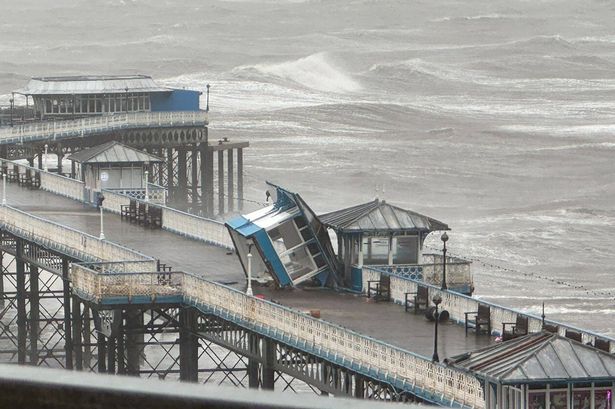The iconic Llandudno Pier, a testament to Victorian engineering and a beloved landmark of the Welsh seaside town, recently fell victim to the wrath of Storm Darragh. The storm, characterized by fierce winds and torrential rain, lashed the North Wales coast, leaving a trail of destruction in its wake. Llandudno Pier, jutting out defiantly into the Irish Sea, bore the brunt of the storm’s fury, suffering significant damage that underscores the vulnerability of even the most robust structures to the unpredictable power of nature. One kiosk, ripped from its moorings, became a stark symbol of the storm’s destructive force, while several others sustained roof damage, leaving debris scattered across the pier’s historic wooden deck. The extent of the damage serves as a reminder of the ongoing battle against the elements faced by coastal communities and the structures that define their identity.
The damage sustained by Llandudno Pier during Storm Darragh is not an isolated incident. Piers, by their very nature, are exposed structures, vulnerable to the full force of wind and waves. Their precarious position at the interface between land and sea makes them particularly susceptible to damage during severe weather events. Historically, piers across the UK have suffered similar fates, battered and bruised by storms that have tested their structural integrity. While modern engineering techniques and materials have improved their resilience, they remain susceptible to the unpredictable forces of nature. The recent damage to Llandudno Pier highlights the ongoing need for robust maintenance and periodic assessments to ensure the long-term survival of these iconic structures in the face of increasingly volatile weather patterns.
Llandudno Pier, opened in 1878, represents more than just a collection of wooden planks and iron supports. It is a symbol of the town’s history, a vibrant hub of activity, and a cherished landmark for both residents and visitors. Stretching over 700 meters into the sea, the pier is home to a variety of attractions, from traditional amusement arcades and food stalls to captivating views of the surrounding coastline and the majestic Great Orme. The pier has witnessed generations of families strolling along its deck, enjoying the fresh sea air and the vibrant atmosphere. Its recent damage, therefore, is not just a structural setback, but a blow to the heart of the community, disrupting livelihoods, and impacting the town’s tourism economy.
The immediate aftermath of Storm Darragh saw the pier closed to the public as assessments of the damage began and the arduous task of cleaning up the debris commenced. Structural engineers meticulously surveyed the extent of the damage, evaluating the stability of the pier and identifying areas requiring immediate repair. The dislodged kiosk, a testament to the storm’s power, was carefully removed, and the damaged roofs of other kiosks were assessed for repair or replacement. The pier’s management team worked diligently to ensure the safety of the structure and to begin the process of restoration, aiming to reopen the pier to the public as soon as possible. The clean-up operation involved removing debris, securing loose materials, and assessing the structural integrity of the pier’s various components.
The process of repairing and restoring Llandudno Pier to its former glory is a complex undertaking, involving multiple stakeholders, from the pier’s owners and management to local authorities, insurance companies, and specialist contractors. The repairs will require careful planning and execution, using materials that are both durable and in keeping with the pier’s historical character. The restoration efforts will not only focus on repairing the immediate damage but also on strengthening the pier’s resilience to future storms, potentially incorporating innovative design solutions and materials to enhance its ability to withstand extreme weather conditions. The cost of the repairs is likely to be substantial, highlighting the financial burden that such events place on coastal communities and the importance of investing in robust infrastructure.
The story of Llandudno Pier and its encounter with Storm Darragh serves as a microcosm of the broader challenges faced by coastal communities in an era of climate change. As extreme weather events become more frequent and intense, the vulnerability of coastal structures and the communities that depend on them is increasingly apparent. The damage to Llandudno Pier underscores the need for proactive measures to mitigate the impacts of climate change, from investing in robust coastal defenses and resilient infrastructure to implementing sustainable land management practices and reducing greenhouse gas emissions. The restoration of Llandudno Pier will not only restore a beloved landmark but also symbolize the resilience of the community and the ongoing commitment to protecting our coastal heritage in the face of a changing climate. The pier’s revival will be a testament to the enduring spirit of Llandudno and a beacon of hope for the future of coastal communities around the world.














